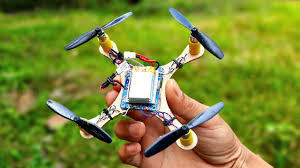Ever since those awesome drone videos started flooding the internet, have you ever felt a tiny voice whisper, “I want to build one of those?” Well, guess what? You totally can! Building a mini drone is a fantastic project that blends creativity with a little engineering magic. Not only is it a fun way to spend some time, but it’s also surprisingly rewarding to get your very own mini aircraft soaring through the air. This guide will equip you with everything you need to know to build your very own mini drone, from understanding the different types to the exciting moment of its first flight.
Why Choose a Mini Drone?
Mini drones, also known as micro drones, are the pint-sized superheroes of the drone world. They’re compact, lightweight, and relatively inexpensive compared to their bigger counterparts. This makes them perfect for beginners who are just starting out with drone flying. You won’t be heartbroken if there’s a minor crash (because let’s be honest, there probably will be a few!), and their small size allows you to fly them indoors or in open spaces without worrying about bothering anyone. Plus, they’re a great way to develop your piloting skills before taking the leap to a larger drone.
Types of Mini Drones: Pick Your Perfect Match
There are two main types of mini drones to choose from:
Basic Mini Drones: These are the ideal choice for beginners. They’re typically built with a simple frame and come with basic flight controls. They focus more on fun and maneuverability than high-tech features.
Camera Mini Drones (XYRC Mini Drone Camera for example): If you crave an aerial perspective, look for a mini drone equipped with a camera. These little marvels can capture photos and videos, allowing you to see the world from a whole new angle. The XYRC mini drone camera is a popular option, known for its compact size and decent image quality.
Beyond these two main categories, mini drones can have additional features like
Altitude Hold: This feature automatically keeps the drone at a set height, making it easier to control.
Headless Mode: This mode makes the drone fly based on the direction of the controller, regardless of which way the drone is facing. Perfect for those times when you get disoriented!
One-Key Return: With a press of a button, this feature brings the drone back to its starting point. A lifesaver when your mini explorer gets a little too adventurous.
The Build Process: From Humble Parts to Soaring Success
Building your mini drone is an exciting adventure. Here’s a breakdown of the steps involved:
Gather Your Supplies
There are a few different ways to approach this. You can buy a pre-made mini drone kit that comes with all the parts you need. Or, if you’re feeling adventurous, you can source the parts yourself. Here are some of the common components you’ll likely need:
Frame (often made from lightweight materials like carbon fiber or plastic)
Motors (the tiny engines that power the propellers)
Propellers (the spinning blades that create lift)
Flight Controller (the brain of the drone, controls flight stability)
Battery (the power source)
Receiver (receives signals from the controller)
Transmitter (the controller you use to pilot the drone)
(Optional) Camera (for capturing photos and videos)
Assemble the Frame:
This step will vary depending on your chosen kit or design. Carefully follow the instructions to put the frame together.
Attach the Motors and Propellers
Make sure you mount the motors in the correct orientation as specified in the instructions. Improper motor placement can lead to a wobbly and uncontrollable flight!
Install the Flight Controller and Other Electronics
This is where things might get a little fiddly. Carefully connect the flight controller, receiver, and other electronic components to the frame, following the instructions provided.
Calibrate the Flight Controller
This crucial step ensures the flight controller accurately reads information from the gyroscope and accelerometer, allowing it to maintain stable flight.
Bind the Controller and Drone
This creates a connection between the controller and the drone, allowing you to take control. The binding process will be specific to your chosen electronics, so consult the manuals.
Charge the Battery and Prepare for Takeoff!
Congratulations! You’ve built your very own mini drone. Charge the battery according to the manufacturer’s instructions, and find a safe and open space for your first test flight.
Tips for a Successful First Flight
Start in a calm and open space: Avoid windy conditions and keep your flying buddy (a friend to observe and help out) within sight. An empty field, park, or large indoor space with plenty of clearance is good options.
Read the Controller Manual: Familiarize yourself with the controls and features of your transmitter before launching your mini drone.
Practice Makes Perfect: Start by hovering the drone at low altitudes before attempting any fancy maneuvers. Get comfortable with the controls and how the drone responds to your inputs.
Take it Slow and Steady: Don’t try to be a drone-racing champion on your first flight! Focus on controlled movements and getting a feel for the drone’s handling.
Safety First: Always keep your eye on the drone and be aware of your surroundings. Mini drones can move surprisingly fast, so be mindful of people and objects in the vicinity.
Soaring Through the Skies: The Joys of Mini Drone Ownership
Owning a mini drone opens up a world of possibilities. Here are some of the cool things you can do with your creation:
Capture Stunning Aerial Photos and Videos: See the world from a whole new perspective! Take breathtaking photos of landscapes, capture unique angles of your house or neighborhood, or even film your pet’s adventures in the backyard.
Navigate Tight Spaces and Get Creative: Mini drones can squeeze into places that bigger drones can’t. This allows for some creative filming opportunities, like capturing footage inside buildings or exploring narrow pathways.
Test Your Piloting Skills: Mini drones are a great way to hone your piloting skills before moving on to larger drones. The small size allows for safe practice in confined spaces, helping you master control and maneuverability.
Endless Fun and Entertainment: Let’s face it, flying a mini drone is just plain fun! Race your friends, practice tricks, or simply enjoy the feeling of controlling your very own mini aircraft.
Conclusion
Building and flying a mini drone is an incredibly rewarding experience. It combines the satisfaction of creation with the thrill of flight. This guide has equipped you with the knowledge and steps to embark on your mini drone adventure. So, gather your supplies, unleash your inner engineer, and get ready to experience the magic of flight firsthand!
FAQs
How much does it cost to build a mini drone?
The cost can vary depending on the complexity of the drone and the quality of the parts. Basic mini drone kits can be found for under $50, while more advanced models with features like cameras can cost upwards of $100.
Is it difficult to build a mini drone?
Building a mini drone can be challenging, but it’s definitely achievable with some patience and following the instructions carefully. If you’re a complete beginner, consider starting with a pre-made kit that comes with detailed assembly instructions.
Where can I fly my mini drone?
Always check local regulations before flying your mini drone. In general, it’s best to avoid flying near airports, populated areas, or crowds of people. Look for open spaces with good visibility and minimal obstacles.
What happens if my mini drone crashes?
Unfortunately, crashes are a part of the learning process when flying drones. Mini drones are typically more durable than their larger counterparts, but it’s always a good idea to start practicing in a safe space with plenty of clearance in case of a mishap.
With this knowledge under your belt, you’re well on your way to becoming a mini drone whiz! Now get out there, build your drone, and take to the skies!




